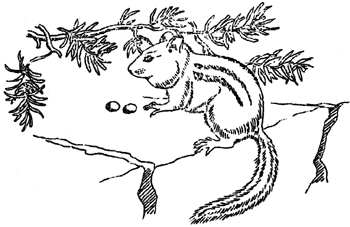|
Volume XXIII - 1992
90th Anniversary Edition
Mammals of the Pumice Desert
By Ruth Monical and Stephen P. Cross
Much of the Crater Lake National Park is covered in forest. One
visible exception is the Pumice Desert on the road to the park's north
entrance. At first glance this 5 1/2 mile square, nearly flat opening
appears to be quite barren except for a few scattered lodgepole pine
(Pinus contorta). A closer look reveals that many forms of life,
including several mammals, use this landscape as a habitat.
At a mean elevation of 5,960 feet, the Pumice Desert is in the
Klamath River drainage basin. Yet it is but two miles from the Umpqua
River and Rogue River tributaries. Elizabeth Mueller Horn studied the
ecology of the Pumice Desert and described the vegetation, which largely
consists of herbaceous plants with very sparsely scattered lodgepole
pine. She found only 14 plant species with total cover of 4.6 percent.
All plants except the lodgepole pine are small herbaceous or woody
stemmed forms with various adaptations for surviving in the absence of
summer surface moisture and relatively high temperature. The poorly
developed soil is relatively porous and deficient in several minerals, a
further cause of the depauperate flora. The resulting lack of cover
increases daytime summer temperatures, creating a relatively unique park
habitat resembling parts of the Great Basin Desert to the east.
Interestingly enough, several animals are adapted for living in the
Pumice Desert's rather harsh micro-habitat. Mammals are an excellent
example of the way in which some animals cope with the conditions of
extreme temperatures and seasonally restricted food and water. The
mammals that occupy the Pumice Desert are either well adapted for living
in these restrictive conditions, or are highly mobile, and use the area
on a temporary basis, or are simply passing through during movement to
more preferred habitat. Field studies by one of us (Monical) indicate
that only three mammal species appear to be permanent residents, far
fewer than in other park habitats. The Great Basin pocket mouse
(Perognathus parvus) and the deer mouse (Peromyscus
maniculatus) occur in significant numbers. One summer's live
trapping (168 traps set for ten nights) resulted in the capture of 54
individual pocket mice and 46 deer mice.
The Great Basin pocket mouse, a seed-eating specialist, is common in
the high desert habitat of western North America. It carries food in its
fur lined cheek pouches for storage in a burrow. The ability to
metabolize moisture from its food allows the pocket mouse to survive
with no free water This nocturnal species also closes its burrow during
the day to help maintain a moist environment. When conditions become too
severe, it will estivate in the summer or become inactive during the
winter.
The deer mouse is the park's most ubiquitous species, utilizing many
different habitats. A highly omnivorous animal, it is able to survive on
a variety of vegetative parts, insects, and has even been known to eat
other small mammals. Though mostly nocturnal, the deer mouse at times
can be seen just before dark when it begins its search for food. An
additional adaptation leading to its continuing survival in harsh
conditions is its high reproductive rate.
A third, less abundant, resident is the western pocket gopher
(Thomomys mazama). Its mounds are seen on the periphery of the
desert near the forest edge, where the texture of the pumice soil is
more conducive to its underground habits. Gophers are active in the
winter and sometimes fill their above-ground burrows under the snow with
soil. After melt, these serpent-shaped ridges are evidence of the
previous winter's activity.
Other captured or observed rodents, considered transients, are the
yellowpine chipmunk (Tamias amoenus), golden mantled ground
squirrel (Spermophilus lateralis), bushy tailed woodrat
(Neotoma cinerea), and porcupine (Erethizon dorsatum). It
is also likely that snowshoe hares (Lepus americanus), mule deer
(Odocoileus hemionus), and perhaps elk (Cervus elaphus),
occasionally venture into this area of marginal habitat. Some species of
bats that roost in the nearby forest use the open areas for foraging.
Predators are rare but could include the red fox (Vulpes vulpes),
coyote (Cants latrans), ermine (Mustela erminea), and
long- tailed weasel (Mustela frenata). The pronghorn antelope
(Antilocapra americana), sometimes sighted in the park, is known
to use open areas such as the Pumice Desert. This location represents
one of the westernmost extremes of the current range for this species,
usually a Great Basin inhabitant.
Mammals utilize the Pumice Desert for a variety of reasons, even
though the harsh environmental conditions preclude most as residents.
The presence of the Great Basin pocket mouse as a permanent inhabitant
there creates a unique combination of species for Crater Lake National
Park.

L. Howard Crawford, Nature Notes, Vol. VIII, No.
3, September 1935.
|

